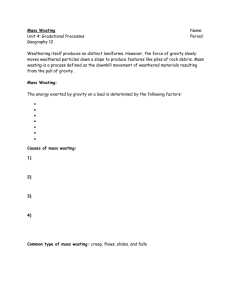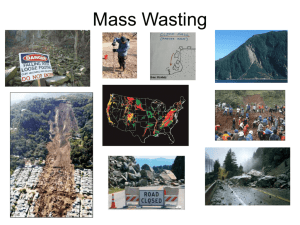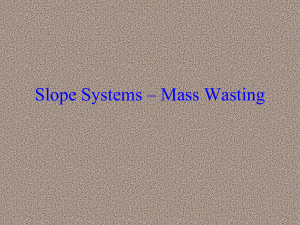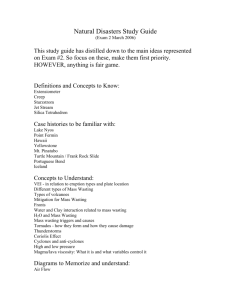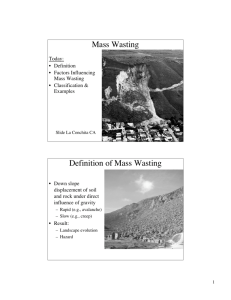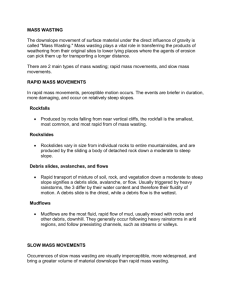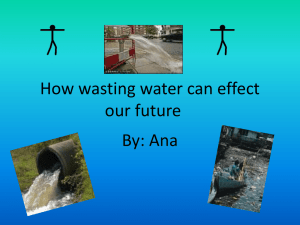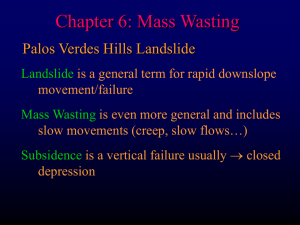MASS WASTING
advertisement
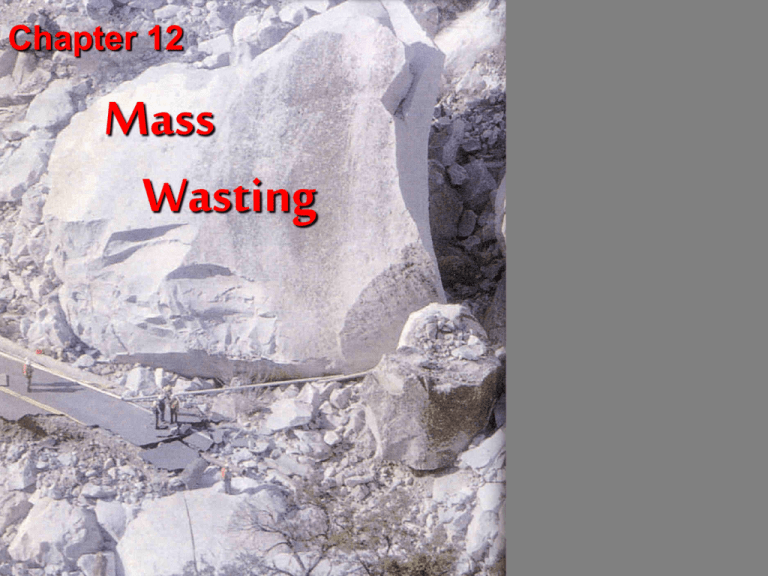
Chapter 12 Mass Wasting MASS WASTING 1. 2. 3. 4. 5. 6. 7. 8. Ch. 12 Mass wasting Landform development Controls and triggers Mass wasting processes Rock slides Earth creep Earth flow Debris and mud flow Slump and debris slides MASS WASTING 1) Landform development “Mass wasting” downslope movement of rock, regolith, soil from force of gravity one form of erosion follows weathering mass-wasting + running water = stream valleys Mass wasting and streams sculpt Earth’s surface MASS WASTING 2) Controls and triggers controlling force: gravity other important factors: water saturation Water fills pore spaces between sediments, reduces internal resistance, adds weight over-steepened slopes Too steep = unstable angle of repose = steepest stable angle of a slope vegetation removal Plants add slope stability by protection against erosion earthquakes Strong ground vibrations Talus slope, Wheeler Peak, Great basin Natl Park Angle of repose: Steepest slope that can remain stable Sand has a small angle of repose, with increasing grain size and angularity the angle increases Moisture means larger angle of repose Fig. Story 12.1 Gravitational force which is directed to Earth’s center, it has two components (vectors). Friction is a force directed opposite to the downslope force. Vector diagram Downslope force Normal force Angle of dip If down slope force < friction, rock stays put Friction Downslope force Vector diagram Normal force Angle of dip If we steepen slope, down slope force > friction, rock starts sliding. The angle where that happens is the angle of repose. Friction Downslope force Vector diagram Normal force Angle of dip Mass movements occur when the force of gravity (meaning the downslope component) exceeds the strength (meaning frictional adhesion) of the slope materials. MASS WASTING 3) Mass wasting processes Type of material Soil/regolith -or- rock/bedrock Type of motion Fall - free-fall of material Slide - coherent material slides along defined surface Flow - material flows as viscous fluid Rate of movement Fastest - rock avalanche: floats (flows) on trapped air Slowest - creep: inches per year (or less) Talus slopes MASS WASTING 4) Rockslide Blocks of bedrock break loose, slide down slope usually where strata are inclined causes: Base of slope is undercut Rain or melting snow lubricates a sliding surface MASS WASTING 5) Earth creep Creep Slow downhill movement of material. From alternate expansion/contraction of material from freezing/thawing or wetting/drying MASS WASTING 6) Earthflow humid areas hillsides rich in clay/silt slow rates MASS WASTING 7) Debris and mud flow Flow of soil/regolith containing lots of water Also called mudflows Common to semi-arid regions, volcanoes (lahars) Very hazardous MASS WASTING 8) Slump and debris slides downward sliding of material moves as a whole section on curved surface usually slow, material doesn’t go far often involves multiple blocks commonly due to slope over-steepening Fig. 12.6 MASS WASTING Some MC…. Which of the following statements is false? A. Mass movements occur when the force of gravity exceeds the strength of the slope materials. B. Mass movements can be triggered by earthquakes and floods. C. Materials can move down a slope very slowly or as a sudden, catastrophic, large movement. D. Mass movements require wind or running water. MASS WASTING Some MC…. Which of the following is not an important factor in causing mass movements? A. B. C. D. amount of water in materials nature of slope materials steepness and instability of slopes temperature of slope materials MASS WASTING Some MC…. A hill consisting of loose, dry sand that slopes at the angle of repose and has no vegetation ______. A. B. C. D. is stable unless oversteepened by excavation may flow if it becomes saturated with water will be more stable if vegetation takes root on the hill all of the above MASS WASTING Some MC…. What is the difference between a rockslide and a rock avalanche? A. In a rockslide, the rocks move more or less as a unit, whereas in a rock avalanche the rocks move independently like a fluid. B. In a rockslide, the rocks move independently like a fluid, whereas in a rock avalanche the rocks move more or less as a unit. C. A rockslide is faster than a rock avalanche. D. A rockslide involves more debris than a rock avalanche. MASS WASTING Some MC…. Which of the following statements about mudflows is false? A. B. C. D. Mudflows tend to move slower than debris flows. Mudflows are most common in semi-arid regions. Mudflows contain large amounts of water. Mudflows can carry large boulders. MASS WASTING Some MC…. Telephone poles that lean slightly downhill are a likely result of which of the following processes? A. B. C. D. creep debris slide earthflow rock avalanche MASS WASTING Some MC…. A slump is __________. A. B. C. D. a rock flow a rock slide a flow of unconsolidated material a slide of unconsolidated material
